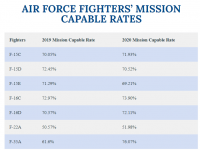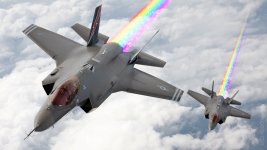The JSF/F-35 is an example of the glittering virtualisation of the US armed forces. The Pentagon's export control and export services have established protocols to ensure that they have effective control of the aircraft on export, while US users are instructed not to "risk" the aircraft in real-world operational conditions where it might get dirty.
Even the Israelis, who have had the F-35 for three years, are extraordinarily discreet ('stealth') about its operational use, - in contrast to their habit of intensively using a new weapon in their arsenal with the hoped-for deterrent effect.
In the end, it is the director of the Air Power Australia website, Peter Goon, who best defines it, citing the most spectacularly sham and fake financial system of the 2000s:
This scheme has all the characteristics of a Ponzi scheme. When the product doesn't work, recruit as many customers as you can, promote it as best you can, make as much money as you can while the market ignores its failures.
Another dimension of this virtualisation approach is the naval dimension. Until now, the U.S. Navy's presence on the world's seas has been marked by the large attack aircraft carriers (CVNs), of which it has ten in principle, on the main routes and at the central strategic points.
Recently, it has been observed that in important theatres, the flagship function has been entrusted to lower category aircraft carriers, either amphibious assault (LCD) or command (LCC). In recent weeks, the LCD USS 'Essex' performed this function in the Gulf, and the LCC USS 'Mount Whitney' in the Black Sea (and Mediterranean).
The fate of the CVNs is more difficult to determine, with the USS 'Harry Truman' expected to be decommissioned, and the brand new USS 'Gerald R. Ford' in endless trouble. Temporary lay-ups for maintenance, repair and modernisation are taking up more and more time and money.
Another kind of explanation for a certain fading of the big CVNs of the U.S. Navy is of course the fear of Russian and Chinese hypersonic missiles in case of conflict, according to a Russian naval expert. They prefer to put their aircraft carriers at a distance from greater security. This in itself is a kind of admission of weakness, like a defeat if you like.
This process is essentially about the desire of military leaders and the national security community not to lose any of the major axes of what was once Americanist hegemony; if you like, it is about "keeping up appearances", with the colossal Pentagon budget, sewn up in every direction and in every way by waste, corruption and impotence, acting as an inescapable reference point for the quick-witted.
In this process and given the loss of real means and the weakening of operational capacities, the strategic situation is becoming increasingly tense and there is this search for completely artificial and simulacrum substitutes to continue to appear hegemonic.
One cannot end this review of the virtualisation of the US armed forces without mentioning the 'wokenisation' of the forces, which contributes to a sharp decline in their combat capabilities, cohesion, sense of mission and duty, etc. The process of virtualisation fits quite well with the current situation. The process of virtualisation corresponds quite well to wokenisation, which is another radical way of virtualising oneself; in both cases, there is radical deconstruction and destructuring ('deconstructuring'); all this, in the logic of our times gone mad.
In a way, we are witnessing a mutation of the US armed forces, their transmutation, both operational and psychological. It is an original show.

www.forbes.com

www.opex360.com













